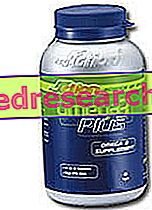
Information on Omega 3 Plus - ProAction
OMEGA 3 PLUS-PROACTION
Food supplement of omega 3 essential fatty acids
FORMAT
Pack of 60 capsules
COMPOSITION
Concentrated fish oil in EPA + DHA,
Edible gelatin, resistance agent: glycerol E422, essential lemon oil, D alpha tocopheryl acetate (Vitamin E acetate). Contains traces of lecithin.
Nutritional information
Media Analysis | Per daily dose (2 cps) | % RDA |
Energy value | 22 Kcal / 90.75 Kj | - |
Protein | 0.438 g | - |
Carbohydrates | 0.224 g | - |
Grassi | 2, 220 g | - |
of which: | ||
Saturated | 0.040 g | - |
Monounsaturated | 0.358 g | - |
polyunsaturated | 1, 598 g | - |
EPA | 0.600 g | - |
DHA | 0.400 g | - |
Vitamin E | 10 mg | 100 |
Fish oil | 2.22 g | - |
Product features Omega 3 Plus - ProAction
Product features: Omega 3 Plus provides omega 3 fatty acids, extracted through molecular distillation from fish oil from the northern seas, and added with lemon oil and with vitamins E to protect them from oxidation. The aforementioned product guarantees a titration in EPA and DHA of 50%, therefore for each capsule of 1 gram we will find about 500 mg. Unfortunately, even in this case there is no IFOS certification that certifies the quality of the product and the absence of pollutants and heavy metals.
Omega 3 fatty acids - characterized by the presence of double bonds, therefore defined polyunsaturated, are particularly important from the biological point of view, so as to be defined as essential for human health.
Our organism is characterized by the presence of biochemical pathways able to guarantee the synthesis of omega-three, however insufficient to satisfy the daily requests. Therefore feeding remains the main source of supply of these nutrients, allowing on average to cover their daily needs - estimated at around 2 grams - simply by consuming 4 weekly fish-based meals.
Their importance for human health is associated with some specific fatty acids, known as EPA, eicosapentanoic acid and DHA, docosaesaeonico, particularly present in fish and in very small part synthesized by the human organism starting from alpha linolenic acid.
There are different scientific evidences that support the beneficial, therapeutic and preventive role of these molecules, although they have not completely characterized the molecular mechanism of action.
The effects are particularly sought after:
- Anti-inflammatory and anticoagulants: thanks to the modulation of the intracellular signals and to the increased synthesis of prostaglandins and leukotrienes with anticoagulant and anti-inflammatory activity;
- Neurotrophic and neuroprotective: through the protection of nervous structures and therapeutic action against major depression;
- Cardioprotective and antiarrhythmogens: probably associated with the structural role of these fatty acids in the formation of plasma membranes;
- Estimates: several studies have noted that the correct intake of omega 3 can determine protection against cardiovascular diseases, type 1 diabetes and some cancers.
To better understand the importance of correct integration it is necessary to consider that these effects are achieved only through the rebalancing of the relationship between omega 6 fatty acids and omega 3 fatty acids. More precisely, recent studies have estimated that this ratio in the western population is it is around 20: 1, much higher than the optimal 3: 1, and probably responsible for the high incidence of cardiovascular diseases.
Omega 3 fatty acids and sports
There are several possible applications of omega 3 fatty acids in sports dietetics. In most cases, they are used for preventive purposes, to avoid the damage caused by intense physical exercise and to preserve the muscle and tendon structures from injury. Recent evidence also suggests a series of very interesting systemic effects for the well-being of the athlete; the benefits derived from the correct intake of these nutrients are reflected in:
- Improved cardiac and vascular function: guaranteed by the cardio-stabilizing and anticoagulant effect;
- Improved ventilatory capacity, necessary to support the athlete's oxygenation;
- Prevention from injuries, achieved through a modulation of inflammatory processes and a significant reduction in tissue insults;
- Improvement of reactive and concentration capacities.
To these effects is added one, not yet fully characterized, which would be particularly important for the health of the athlete MAN, and which would be explained by the inhibition of the enzyme alpha 5 reductase (responsible for the conversion of testosterone into dihydrotestosterone) and the consequent reduction of some of the potentially harmful androgenic effects, responsible for example for prostatic hypertrophy and hair loss.
Recommended use by the company - Omega 3 Plus - ProAction
We recommend 2 capsules a day, taken during or after meals.
Use in sports - Omega 3 Plus - ProAction
Although many manufacturers suggest an optimal dosage of between 2 and 6 grams per day, with an optimum of 2.4 g according to scientific literature, in order for the supplementary protocol to be truly effective, it is necessary to adapt the quota to that assumed through the diet, comparing it to the dietary content of omega 6. We recall in fact that in order for integration to guarantee tangible results, it is important to rebalance the omega 6 / omega3 ratio. In any case, the intake should be preferred during meals, in order to optimize the digestive and absorption processes, and continued for as long as necessary to re-establish the aforementioned relationship, which can be easily rebalanced also through a healthy diet.
Synergies - Omega 3 Plus - ProAction
Several studies show a greater efficacy of action associating to the omega 3 antioxidant substances able to assist the protective action on the stability of the plasma membranes.
Furthermore, for supplementation to guarantee the effects described, it is also necessary that the diet follows the general principles of a healthy diet and is accompanied by controlled exercise.
Side effects Omega 3 Plus - ProAction
Excessive intake of omega 3 can be associated with immediate phenomena such as nausea, vomiting, gastric and erythema burning, and systemic effects of a different nature.
In the literature, cases of bleeding (due to the anticoagulant action of the omega 3) are described; therefore it is necessary to pay attention to possible interactions with aspirin or other anticoagulants, and in the case of haemophilic pathology or alterations of the glycemic profile in patients suffering from non insulin dependent diabetic pathology.
It should be reiterated that the dose between 2 and 5 grams per day seems to be quite safe, and without the aforementioned side effects.
Precautions for use Omega 3 Plus - ProAction
The product is contraindicated in cases of renal or hepatic disease, cardiovascular disease and / or hypertension, allergies and autoimmune diseases, during pregnancy, during breastfeeding, under 12 years and for adolescents not yet trained.
In the event of prolonged use (over 6/8 weeks), medical advice is required.
This article, elaborated on the critical re-reading of scientific articles, university texts and common practice, is for informational purposes only and is therefore not a medical prescription. It is therefore always necessary to consult your doctor, nutritionist or pharmacist before starting to use any kind of supplement . Further information on the critical analysis of Omega 3 Plus - ProAction.
| BIBLIOGRAPHY |
J Am Coll Nutr. 2009 Aug; 28 Suppl: 473S-481S. Effect of omega-3 and policosanol supplementation on attention and reactivity in athletes. Fontani G, Lodi L, Migliorini S, Corradeschi F. Int J Sport Nutr Exerc Metab. 2009 Oct; 19 (5): 536-46. n-3 polyunsaturated fatty acidsNieman DC, Henson DA, McAnulty SR, Jin F, Maxwell KR. Nutr Res. 2009 May; 29 (5): 305-12. Cardiovascular risk factors in young, overweight, and obese Europeans and associations with physical activity and omega-3 index.Ramel A, Pumberger C, Martinéz AJ, Kiely M, Bandarra NM, Thorsdottir I. J Sci Med Sport. 2010 Mar; 13 (2): 281-6. Epub 2009 Jun 12. The effects of omega-3 supplementation on pulmonary function of young wrestlers during intensive training.Tartibian B, Maleki BH, Abbasi A. Clin J Sport Med. 2009 Mar; 19 (2): 115-9. The effects of ingestion of omega-3 fatty acids on perceived pain and external symptoms of delayed onset muscle soreness in untrained men.Tartibian B, Maleki BH, Abbasi A. Eur J Appl Physiol. 2008 Oct; 104 (3): 455-61. Epub 2008 Jun 18. Omega-3 fatty acid supplementation enhances stroke volume and cardiac output during dynamic exercise.Walser B, Stebbins CL. J Sci Med Sport. 2009 Jul; 12 (4): 503-7. Epub 2008 Jun 13. DHA-rich fish oil lowers heart rate during submaximal exercise in elite Australian Rules footballers.Buckley JD, Burgess S, Murphy KJ, Howe PR. Curr Sports Med Rep. 2007 Jul; 6 (4): 230-6. Omega-3 fatty acids and athletics.Simopoulos AP. Am J Clin Nutr. 2007 Mar; 85 (3): 803-7. n-3 Fatty acids are positively associated with peak bone mineral density and bone accrual in healthy men: the NO2 Study.Högström M, Nordström P, Nordström A. J Psychiatr Res. 2008 Jan; 42 (1): 58-63. Epub 2006 Oct 30. Omega-3 fatty acids on the forced-swimming test.Huang SY, Yang HT, Chiu CC, Pariante CM, Su KP. Eur J Appl Physiol. 2004 Aug; 92 (4-5): 584-91. Epub 2004 Mar 30. Effect of n-3 fatty acids on free tryptophan and exercise fatigue.Huffman DM, Altena TS, Mawhinney TP, Thomas TR. Crit Care Clin. 2010 Jul; 26 (3): 501-514. Fish Oil in Critical Illness: Mechanisms and Clinical Applications.Stapleton RD, Martin JM, Mayer K. J Alzheimers Dis. 2010 Jul 15. [Epub ahead of print] Omega-3 Fatty Acids, Cognitive Decline, and Alzheimer's Disease: A Critical Review and Evaluation of the Literature.Huang TL. Cardiovasc Ther. 2010 Aug; 28 (4): 202-15. Nutraceuticals and atherosclerosis: human trials.Badimon L, Vilahur G, Padro T. Cell Mol Biol (Noisy-le-grand). 2010 Feb 25; 56 (1): 28-37. Omega-3 (n-3) fatty acids, cardiovascular disease and stability of atherosclerotic plaques.Calder PC, Yaqoob P. BMC Cardiovasc Disord. 2010 Jun 3; 10: 24. Omega-3 fatty acids in high-risk cardiovascular patients: a meta-analysis of randomized controlled trials. |



